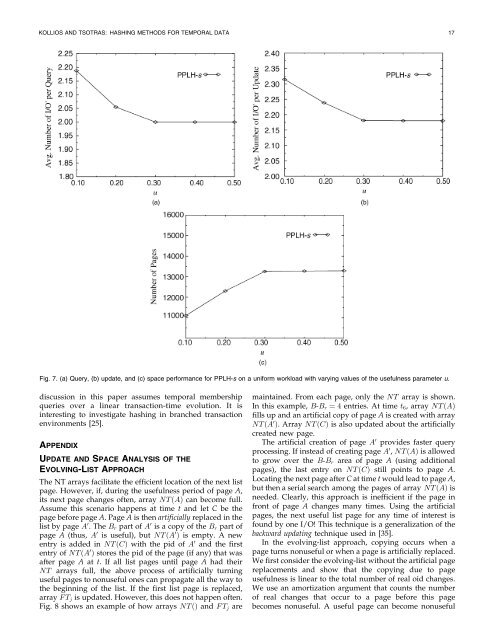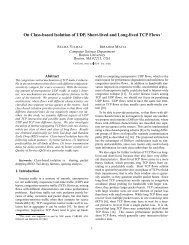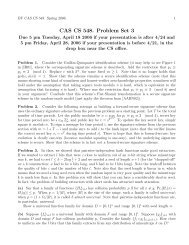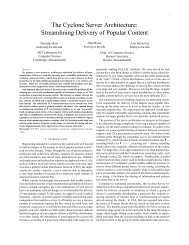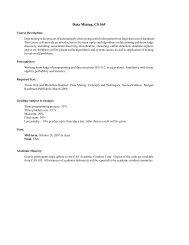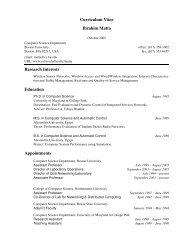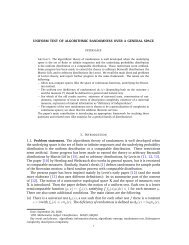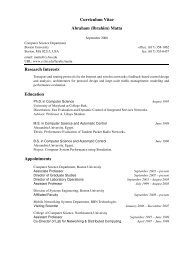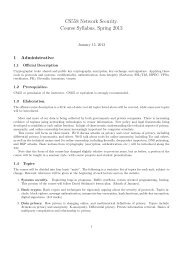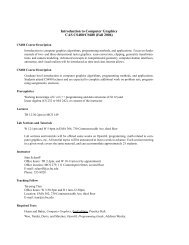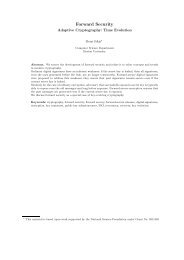Hashing Methods for Temporal Data - Computer Science - Boston ...
Hashing Methods for Temporal Data - Computer Science - Boston ...
Hashing Methods for Temporal Data - Computer Science - Boston ...
You also want an ePaper? Increase the reach of your titles
YUMPU automatically turns print PDFs into web optimized ePapers that Google loves.
KOLLIOS AND TSOTRAS: HASHING METHODS FOR TEMPORAL DATA 17<br />
Fig. 7. a) Query, b) update, and c) space per<strong>for</strong>mance <strong>for</strong> PPLH-s on a uni<strong>for</strong>m workload with varying values of the usefulness parameter u.<br />
discussion in this paper assumes temporal membership<br />
queries over a linear transaction-time evolution. It is<br />
interesting to investigate hashing in branched transaction<br />
environments [25].<br />
APPENDIX<br />
UPDATE AND SPACE ANALYSIS OF THE<br />
EVOLVING-LIST APPROACH<br />
The NT arrays facilitate the efficient location of the next list<br />
page. However,if,during the usefulness period of page A,<br />
its next page changes often,array NT…A† can become full.<br />
Assume this scenario happens at time t and let C be the<br />
page be<strong>for</strong>e page A. Page A is then artificially replaced in the<br />
list by page A 0 . The B r part of A 0 is a copy of the B r part of<br />
page A thus, A 0 is useful),but NT…A 0 † is empty. A new<br />
entry is added in NT…C† with the pid of A 0 and the first<br />
entry of NT…A 0 † stores the pid of the page if any) that was<br />
after page A at t. If all list pages until page A had their<br />
NT arrays full,the above process of artificially turning<br />
useful pages to nonuseful ones can propagate all the way to<br />
the beginning of the list. If the first list page is replaced,<br />
array FT j is updated. However,this does not happen often.<br />
Fig. 8 shows an example of how arrays NT…† and FT j are<br />
maintained. From each page,only the NT array is shown.<br />
In this example, B-B r ˆ 4 entries. At time t 6 ,array NT…A†<br />
fills up and an artificial copy of page A is created with array<br />
NT…A 0 †. Array NT…C† is also updated about the artificially<br />
created new page.<br />
The artificial creation of page A 0 provides faster query<br />
processing. If instead of creating page A 0 , NT…A† is allowed<br />
to grow over the B-B r area of page A using additional<br />
pages),the last entry on NT…C† still points to page A.<br />
Locating the next page after C at time t would lead to page A,<br />
but then a serial search among the pages of array NT…A† is<br />
needed. Clearly,this approach is inefficient if the page in<br />
front of page A changes many times. Using the artificial<br />
pages,the next useful list page <strong>for</strong> any time of interest is<br />
found by one I/O! This technique is a generalization of the<br />
backward updating technique used in [35].<br />
In the evolving-list approach,copying occurs when a<br />
page turns nonuseful or when a page is artificially replaced.<br />
We first consider the evolving-list without the artificial page<br />
replacements and show that the copying due to page<br />
usefulness is linear to the total number of real oid changes.<br />
We use an amortization argument that counts the number<br />
of real changes that occur to a page be<strong>for</strong>e this page<br />
becomes nonuseful. A useful page can become nonuseful


